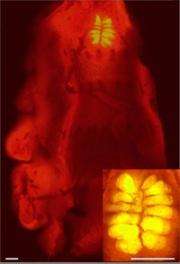Confocal fluorescent image of a human head louse nymph (red) with in yellow the endosymbiotic bacteria whithout which human lice cannot survive. The lice provide for their bacteria chambers that are called mycetomes or bacteriomes. Credits: M.A. Perotti, H.R. Braig
New simple and effective treatments for body and head lice infestations could be developed using clinically 'obsolete' antibiotics. This news follows the completion of genetic sequencing of our oldest and closest human 'neighbour', the human body louse (Pediculus humanus humanus L.). The sequencing of the louse and bacteria that live within the louse are reported in a paper in the American on-line journal, Proceedings of the National Academy of Sciences.
Although living in our clothing, lice are not welcomed. The body louse transmits endemic typhus, relapsing fever and trench fever as well as leaving the host, if not infected with a more serious disease, feeling 'lousy'.
Head lice- while not transmitting disease can, as with body lice, lead to unexpected conditions such as cervical lymphadenopathy or corneal epithelial keratitis. They are also increasingly resistant to current insecticidal treatments. This is leading to endemic infestations, particularly among the young in the west and even more so in developing countries.
As part of the project to genetically sequence the louse genome, parasitologists at Bangor and Reading universities were responsible for sequencing a bacterium (Candidatus Riesa pediculicola) that lives within the louse, and without which, the lice cannot survive. They worked alongside over 25 other institutions in the international research team.
The lice have adopted the bacteria to enable them to gain the vitamins they need to survive, which they are no longer able to obtain from ingested human blood.
Dr Henk Braig, a Molecular Parasitologist at Bangor University's School of Biological Sciences explains:
"We have established that these bacteria have no immunity to antibiotics as they have been isolated within the body of the lice and transmitted down the generations for millennia with no outside contact. Having had no other contact with external bacteria, they have had no need to develop resistance to antibiotics- as they would in the wider environment, in their struggle for survival and dominance."
Dr Henk Braig of Bangor University and research collaborator, Dr. Alejandra Perotti of University of Reading therefore propose that antibiotics now clinically ineffective for any other treatments could be used to treat both head and body lice.
Dr Alejandra Perotti at University of Reading, School of Biological Sciences explains further, "We have found the human louse Achilles' heel. All human lice depend on this bacterium for reproduction and survival. This bacterium represents a new target for the development of novel anti-louse agents especially for cases were classical treatment fails. Antibiotics that have completely lost their therapeutic value could now be tested for this target. The potential of antibiotics to fight human lice is not new but we now have a solid scientific basis for this. Several antibiotics might be efficient and should be systematically tested. "
The louse genome sequencing was conducted by the other team members.
"The body louse genome is the smallest known genome of any insect," said University of Illinois entomology professor Barry Pittendrigh, who led the drive to fund the project and coordinated the international team of scientists who analyzed the sequence.
The body louse also has "the smallest number of detoxification enzymes observed in any insect," the researchers wrote. John Clark, of the University of Massachusetts at Amherst, and Si Hyeock Lee, of Seoul National University, led this part of the analysis. The body louse's pared-down list of detoxifying enzymes makes it an attractive organism for the study of resistance to insecticides or other types of chemical defence, Pittendrigh said. University of Illinois entomology professor and department head May Berenbaum and former graduate student Reed Johnson contributed to this effort.
Provided by Bangor University





















